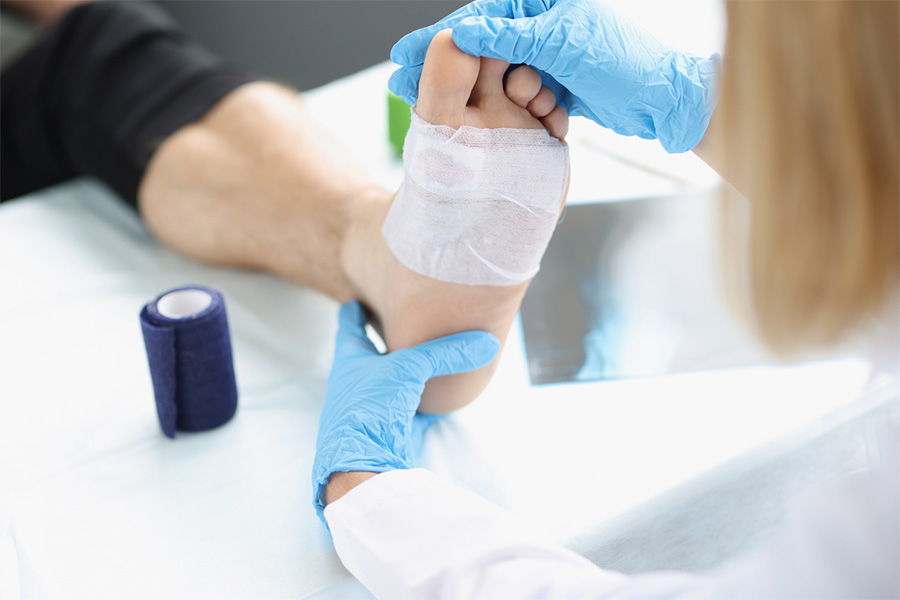An infected foot can be painful and can make it difficult to walk and carry out normal day-to-day activities. A foot infection can occur for a variety of reasons, such as from bacteria getting into a wound or from a fungal infection, such as athlete’s foot.
Foot infections, especially those caused by infected wounds, should not be taken lightly. They should be examined by a skilled podiatrist in order to treat the infection effectively and to prevent it from developing into a more serious infection.
What Are the Symptoms of a Foot Infection?
An infected foot can be very painful, and symptoms largely depend on the cause of the infection. Common symptoms of foot infections include:
- Skin and nail discoloration – The infected area may change color. If cellulitis has developed from an infection, it can cause redness or a red spotty rash. Toenail fungus can cause the toenails to discolor, starting as a white or yellow spot under the tip of the nail and becoming more discolored and thick or jagged as the infection worsens.
- Change in skin temperature – The skin around the affected area may feel warm or hot to the touch, compared to the rest of the foot.
- Swelling – Inflammation is a common symptom of an infected foot. The swelling can worsen or spread to the entire foot. It can also make the skin appear shiny or waxy.
- Secretion of pus or fluid – An ingrown toenail can cause a pus-filled pocket under the skin which may ooze out. An abscess or ulcer can also cause pus and fluid in the infected area.
- Odor – A foot infection can cause a bad odor, especially if it began from a wound or a sore. Ingrown toenails can generate odorous pus at the site of the infection.
- Blister – If a foot blister becomes infected, it can cause warmth and redness to the area. The healthy clear fluid in the blister may turn into green or yellow pus.
- Fever – If you experience a fever or symptoms associated with a fever, such as sweating, body aches, or lethargy, this could indicate a more serious infection, such as cellulitis.
Treatment for Foot Infections
Treatments for foot infection can vary depending on the cause and severity of the infection. Minor foot infections such as athlete’s foot may be treated at home with over-the-counter treatments, while more serious foot infections, such as bacterial cellulitis and infected diabetic ulcers, require urgent medical attention.
Home treatments for minor foot infections can include:
- Antifungal creams, powders, or sprays for fungal infections, such as athlete’s foot and fungal nail infections
- Plantar wart-removal treatments, such as salicylic acid
- Antibiotic creams and lotions
- Blister pads
A podiatrist may prescribe special treatments for foot infections. These may include:
- Oral or topical antibiotics
- Antifungal medication, creams, or lotions
- Cryotherapy (freezing) for the removal of plantar warts
- Vacuum-assisted closure of wounds
- Surgery
Your feet play a hugely important role, and keeping them in peak condition is a priority. To ensure that your feet stay in good condition and are free from infection:
- Wash the feet regularly
- Dry the feet well, especially between the toes
- If skin is dry, apply moisturizer (but avoid between the toes)
- Cut toenails carefully (not too short, and always cut straight across to avoid ingrown toenails)
- Avoid tight or uncomfortable footwear
- Regularly inspect feet to check for abrasions or cracks in the skin
- Wear socks that fit (they shouldn’t be too tight)
- Protect your feet in communal areas such as public showers and swimming pools
Types of Serious Foot Infections
There are several types of foot infections that podiatrists diagnose and treat on a regular basis, including the following:
Bacterial Cellulitis
Cellulitis is a bacterial skin infection that needs to be treated immediately, usually with oral antibiotics. Cellulitis can cause the infected area to become red, painful, hot, swollen, and tender, and it may cause a fever and nausea if severe.
This condition can cause potentially serious problems if not treated quickly, such as blood poisoning (sepsis), kidney damage, and ulcers. Sepsis and kidney problems can be life-threatening.
Foot Ulcers
Certain types of foot ulcers require immediate medical treatment. These include:
- Neurotrophic ulcers, which affect people with diabetes or severe nerve damage in their lower extremities. While they may occur anywhere on the foot, these ulcers most often form over pressure points.
- Venous stasis ulcers, which tend to develop in people with varicose veins, blood clots, or recurrent leg swelling. These ulcers typically occur on the inner part of the leg just above the ankle.
- Arterial ulcers develop as the result of poor circulation or peripheral artery disease (PAD). They commonly form on the heels, tips of toes, and between the toes where the toes rub.
Diabetic Foot Conditions
People with diabetes are at an increased risk for developing foot infections and ulcers in the feet because of complications like diabetic neuropathy (nerve damage) and peripheral artery disease (poor circulation), both of which may be caused by years of high blood sugar levels.
Nerve damage can cause a loss of sensation and feeling in the feet, meaning pain can’t be felt – and problems such as foot calluses or cracks in the skin can, therefore, be overlooked. Poor circulation makes it more difficult for wounds and ulcers to heal.
It is imperative for people with diabetes to check their feet regularly and visit a podiatrist for routine examinations to prevent diabetic ulcers. Untreated foot ulcers can lead to serious complications and may require amputation to prevent a life-threatening infection.
Experienced Podiatrists in Cincinnati
Cincinnati Foot & Ankle Care offers comprehensive care for the feet. Our knowledgeable team of podiatrists can provide foot infection treatments, diabetic foot care, and relief for ulcers in the foot and ankle.
To schedule a consultation, contact us at any of our locations in the Cincinnati area or use our convenient online form to request an appointment. We can help get you back on your feet in no time.





